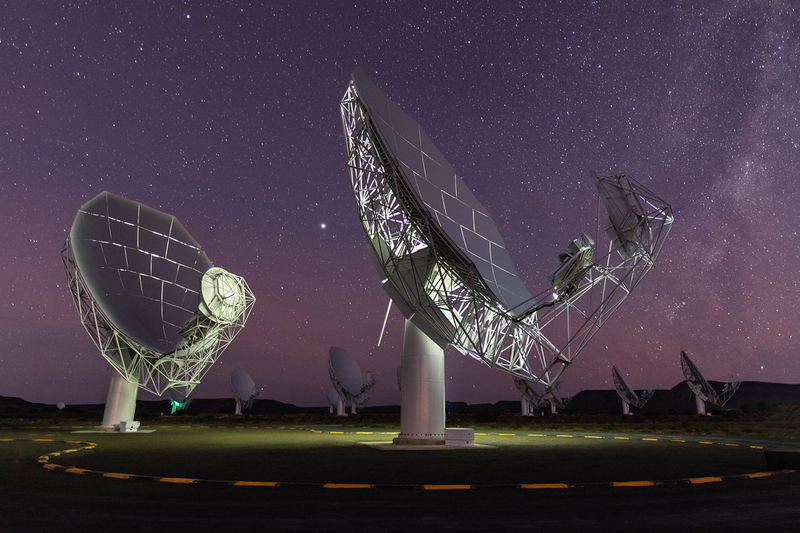South Africa’s MeerKAT finds radio galaxies that dwarf our Milky Way
20 January 2021 | Story Shaun Smillie. Photo South African Radio Astronomy Observatory / SARAO. Read time 7 min.
In a patch of sky long trawled across by countless telescopes, astronomers have discovered two gigantic radio galaxies – all thanks to MeerKAT, which spotted these distant objects from deep in the Karoo.
The two galaxies that have been spotted are so huge that to travel across the biggest one would take a spacecraft moving at the speed of light almost 8 million years.
Another indication of their sizes is that the Milky Way that splashes across our night sky is 62 times smaller than these galaxies.
So, it is not surprising astronomers are now describing these as being among the largest objects in the universe.
“Light left those galaxies roughly when the earth started to form.”
The reason these monster galaxies were only noticed now has to do with their distance from earth – and the technologically advanced MeerKAT radio telescope that has been quietly scanning the skies from deep inside the Northern Cape.
The galaxies are 3.8 billion light years from Earth.
“Light left those galaxies roughly when the earth started to form,” explains Dr Jacinta Delhaize, a research fellow at the University of Cape Town and lead author of the work.
The discovery, which was announced on Monday in the monthly notice of the Royal Astronomical Society, has given scientists hope that similar distant galaxies will be found with the help of MeerKAT.
With their discovery could come a better understanding of how the early universe formed shortly after the Big Bang.
“We suspect that many more galaxies like these should exist, because of the way we think galaxies should grow and change over their lifetimes,” Dr Matthew Prescott, co-author and research fellow at the University of the Western Cape, said in a statement.
Radio galaxies differ from normal galaxies in that they emit more radio waves. And because charged particles interact with the strong magnetic fields near the black hole at its centre, jets of radio “light” are released.
“We suspect that many more galaxies like these should exist, because of the way we think galaxies should grow and change over their lifetimes.”
These tell-tale jets can be many times larger than the galaxy itself, and help identify the presence of a radio galaxy.
“We found it because MeerKAT is just so awesome,” says Delhaize. “We haven’t had a telescope that has been able to see this kind of light before. MeerKAT is incredibly sensitive and is very good at picking up light that is distributed over large patches of sky.”
“This made it possible to detect features that haven’t been seen before. We found large-scale radio jets coming from the central galaxies, as well as fuzzy cloud-like lobes at the ends,” Dr Ian Heywood, a co-author at the University of Oxford, said in a statement.
MeerKAT is different to traditional telescopes where astronomers would eyeball the heavens and make their observations. Instead, MeerKAT uses radio waves to map the universe.
This data is then collected and sent to astronomers who are often thousands of kilometres away, to begin the process of analysing it.
It was in 2018 while looking at data that Delhaize and her colleague Ian Heywood realised they were on to something.
They were working on the MIGHTEE survey, an acronym for the MeerKAT International Gigahertz Tiered Extragalactic Exploration survey. The aim of the survey is to create radio maps of the sky and involves teams of astronomers from around the world.
“Ian was sitting next to me and he said ‘Look, I have just made a map of the sky and you can see this big streak… maybe this is a giant radio galaxy’,” recalls Delhaize.
More data was crunched and different radio wave wavelengths analysed.
“I began working on this in earnest in 2020… this was my lockdown paper,” laughs Delhaize.
Now that Delhaize knows what to look for, she plans to sift through other data for those tell-tale signs of other distant radio galaxies.
“This has been a really good demonstration of what MeerKAT can do… it is such an amazing telescope,” says Delhaize.
“It is really exciting times and I can’t wait to get hold of more data and see what is out there.”
Research & innovation





































